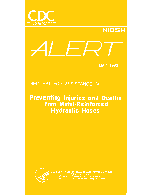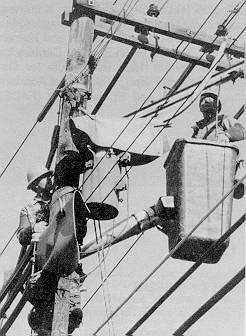Preventing Injuries and Deaths From Metal- Reinforced Hydraulic Hoses
May 1993
DHHS (NIOSH) Publication Number 93-105

WARNING! Workers may be burned or electrocuted when using metal-reinforced hoses on aerial bucket trucks near energized power lines.
The National Institute for Occupational Safety and Health (NIOSH) requests assistance in preventing worker injuries and deaths from the use of metal-reinforced hydraulic hoses or aerial bucket trucks near energized power lines. Reports of one recent fatality indicate that metal-reinforced hydraulic hoses may rupture and cause fires if they contact energized power lines. Electric current flowing through the metal reinforcement may also create an electrocution hazard. The Occupational Safety and Health Administration (OSHA) requires the use of nonconducting hydraulic hoses near energized power lines.
NIOSH requests your assistance in bringing the recommendations in this Alert to the attention of utility companies, electrical contractors, manufacturers of aerial bucket trucks and hydraulic impact tools, insurers of these companies, electrical linemen, and maintenance personnel.
Case Report
A 37-year-old electrical lineman who worked for a contractor recently died when he jumped from a burning aerial bucket and fell 35 feet to the ground [NIOSH 1990]. When the fatal incident occurred, the lineman was sagging (adjusting slack in) the center phase of a three-phase, 12,400-volt, energized power line. A metal-reinforced, rubber hydraulic hose was attached to an impact wrench the line man was using. When the hose simultaneously contacted two phases of the power line, the heat generated by the electric current in the metal reinforcement caused the hose to melt and rupture. When the hydraulic fluid from the ruptured hose contacted the power line, the fluid ignited and the aerial bucket became engulfed in flames. As the fluid continued to spray onto the power line, the fire intensified. The lineman rotated the aerial bucket away from the power line until the bucket controls stopped functioning. He then attempted to jump to an earthen bank about 15 feet from the side of the bucket, but he caught his foot on the bucket lip and fell to the ground, landing on his head and chest.
A field mechanic had installed the metal-reinforced hose 5 months before the fatal incident. During later interviews, the mechanic stated that he knew he was installing the wrong type of hose but did not understand the hazards involved [NIOSH 1990].
Following the fatal incident, the electrical contractor inspected the hydraulic hoses on all of his aerial buckets and found no other metal-reinforced hoses. However, when the local utility company inspected their aerial bucket trucks, they found several metal-reinforced hydraulic hoses on booms or aerial buckets that might be used near energized power lines.
NIOSH is therefore concerned that workers at other utility companies or electrical contracting companies may be exposed to hazards from metal-reinforced hydraulic hoses.
Current OSHA Regulations
OSHA standards require that all hydraulic tools used on or near energized power lines or equipment be supplied with nonconducting hoses having adequate strength for normal operating pressures [29 CFR* 1926.951(f)(3)].
Conclusions
As the case reported here demonstrates, electrical contact between two power line phases through a metal-reinforced hydraulic hose can generate sufficient heat to rupture the hose and cause a fire. In addition, an electrocution hazard can be created if a metal-reinforced hose on the boom of a truck contacts an energized power line and allows current to flow through the truck chassis.
Recommendations
NIOSH recommends that the following precautions be taken to control the hazards associated with hydraulic hoses used on aerial bucket trucks:
- Employers should not install metal-reinforced hydraulic hoses on any part of the boom, aerial bucket, or hydraulic attachments of aerial bucket trucks used near energized power lines [29 CFR 1926.951(f)(3)].
- Employers should remove any metal-reinforced hoses currently installed on any part of the boom, aerial bucket, or hydraulic attachments of aerial bucket trucks used to work near energized power lines.
- Before work begins, employers should require a competent person [29 CFR 1926.32(f)] to conduct an initial and daily jobsite survey and inspect all equipment to identify hazards and implement appropriate controls.
- Employers should stress the importance of adherence to established safe work procedures. These include covering energized power lines in the immediate work area with insulating hoses or blankets (Figure 1), or deenergizing and grounding the lines before work begins. Workers should test deenergized power lines to verify that they have actually been deenergized.
- Employers should provide all workers with task-specific training that shows how each step controls the identified hazard. For example, the field mechanic in the case reported here knew that he was installing the wrong type of hose, but he did not know about the fire or electrocution hazard associated with using a metal-reinforced hose near energized power lines.
- Employers should install all hydraulic hoses used in aerial buckets so that the flow of hydraulic fluid can be stopped immediately by the worker in the bucket. This objective can be achieved by incorporating a control valve into the hydraulic system in the aerial bucket.
- Manufacturers should continue research into the development of hydraulic fluids that are nonflammable and nonconducting.
- Employers should encourage equipment and tool manufacturers to design an independent coupling system to prevent the use of unsuitable hydraulic hoses on booms, aerial buckets, or aerial bucket attachments. Labeling or color coding hoses may also help workers who service this equipment.

Figure 1. Linemen working near energized power lines covered by insulating blankets and hoses.
Acknowledgements
The principal contributor to this Alert was Virgil Casini, Division of Safety Research, NIOSH. Comments, questions, or requests for additional information should be directed to Dr. Thomas R. Bender, Director, Division of Safety Research, 944 Chestnut Ridge Road, Morgantown, WV 26505-2888; telephone, (304) 284-5700.
We greatly appreciate your assistance in protecting the lives of American workers.
[signature]
J. Donald Millar, M.D., D.T.P.H (Lond.)
Assistant Surgeon General
Director, National Institute for Occupational Safety and Health
Centers for Disease Control
Notes
* Code of Federal Regulations. See CFR in references. [Return to body of text]
References
CFR. Code of Federal regulations. Washington, DC: U.S. Government Printing Office, Office of the Federal Register.
NIOSH [1990]. Electrical lineman dies after falling 35 feet to the ground from a burning aerial bucket in South Carolina. Morgantown, WV: U.S. Department of Health and Human Services, Public Health Service, Centers for Disease Control, National Institute for Occupational Safety and Health, Fatal Accident Circumstances and Epidemiology (FACE) Report 90-35.
93-105sum.pdf (Worker/Employer Summary Sheet Only) [PDF - 288 KB]
- Page last reviewed: June 6, 2014
- Page last updated: June 6, 2014
- Content source:
- National Institute for Occupational Safety and Health Education and Information Division


 ShareCompartir
ShareCompartir